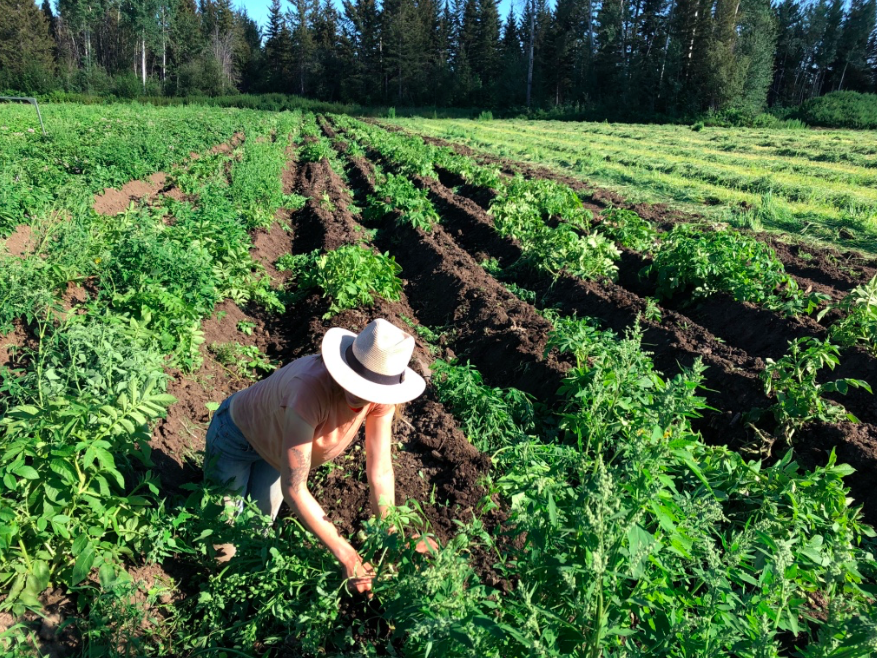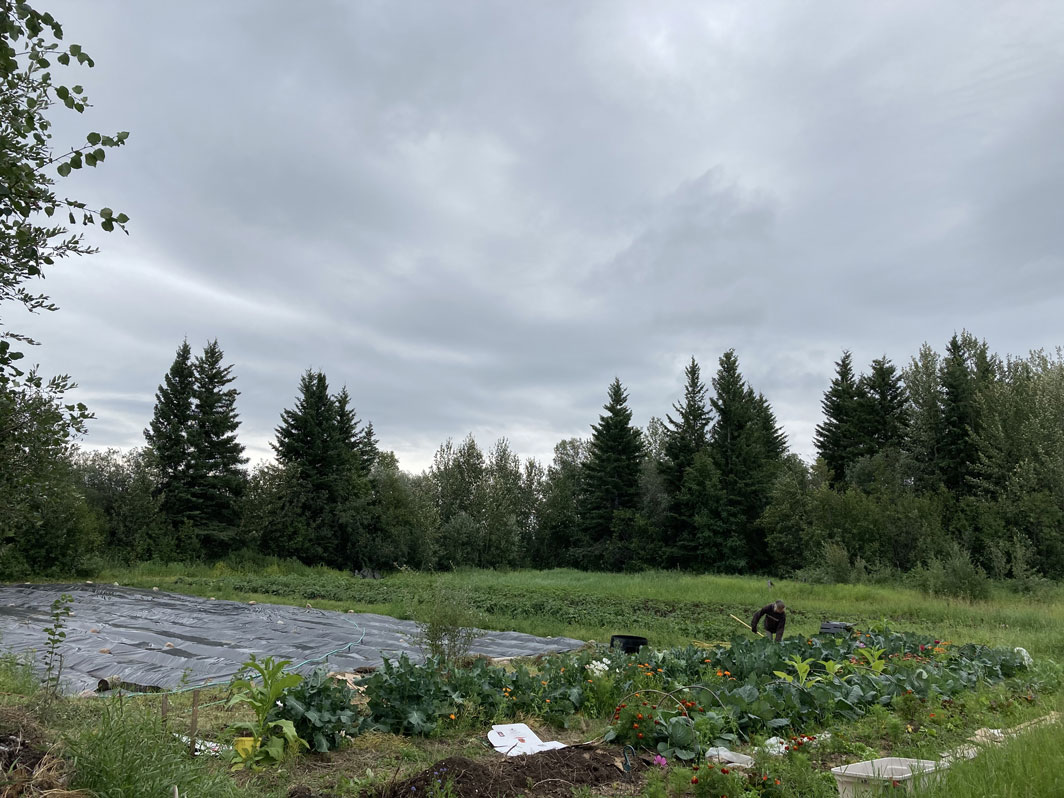
Photo by Austin Price
Amid the snow and ice of Canada’s Northwest Territories, Mindy Jewell Price is immersing herself in the lifestyles and farming practices of Arctic communities.
Since starting her PhD in Environmental Science, Policy, and Management in the Research in Agriculture (RAD) Lab led by professor Kathryn De Master, Price has split her time between Berkeley and three of Canada’s rural communities: Sambaa K’e, Kakisa, and Paradise Gardens. There, she studies how climate change is reshaping the food and agricultural practices of the region’s Indigenous and non-Indigenous residents.
“I've had the privilege of being invited into these communities and integrating into whatever activities people are doing,” she said. For much of the year, that means chopping wood, preserving food, and preparing for the long winter months. But in the spring and summer, when the ice starts to thaw and temperatures begin to rise, Price helps out on family farms and community gardens, usually growing food or managing livestock.
We spoke to Price about her research, life in the Arctic, and how northern communities are adapting to a warmer climate and more unpredictable weather patterns.
This conversation has been edited for length and clarity.
Why did you choose Rausser College?
I previously studied public health and worked in global food security, but I felt constrained by the norms and disciplinary boundaries of public health and development. The social and environmental problems we face today—especially the ones that stem from climate change—require a much broader and more collaborative approach. I wanted to take an interdisciplinary approach that uses theory and different research methods to ask more critical questions about the global food system, which drew me to Berkeley. We have great faculty in ESPM doing critical work on agriculture, and it seemed like a really good fit.

Photo by Austin Price
What does your research focus on?
I study agrarian change in the Northwest Territories (NWT) and more broadly across the circumpolar north. Through historical and archival research and ethnographic fieldwork, I’m trying to understand how climate change might affect agricultural development in the NWT now and in the future. I initially got interested in studying agriculture in the Arctic after reading narratives in both scholarly literature and popular media—including the New York Times and the New Yorker—about climate change warming the North. Studies suggest that longer growing seasons and warmer temperatures with climate change could make it possible to grow crops in the future that you can’t currently grow in Arctic and boreal regions.
This speculation that the Arctic could become a new frontier for agriculture is interesting but would have serious implications for society and the environment. I wanted to see if local people were also talking about this, or if that narrative was solely living in climate models. When I got to the NWT, I shared this narrative of climate-induced Arctic agriculture with farmers, and most of them scoffed at it. They said that climate change is occurring, they have witnessed its real effects, but it's been mostly devastating. Like other places in the world, the North has experienced wildfires, floods, and other challenges related to extreme climate variability.
What does agriculture currently look like in the NWT?

Photo by Mindy Jewell Price
Agriculture is much newer in northern North America than elsewhere in the world, and Canada’s Arctic Indigenous peoples did not traditionally practice agriculture. It came with fur traders and settlers in the late 1700s and early 1800s, but even then, it’s not exactly new: there are 200 years of agricultural history.
There are currently fewer than 12 commercial farms in the NWT. The largest farm is less than 70 acres, according to the census, and historically, there have only been 32 operative commercial farms at any one time. Most of them are diversified and sow mixed market vegetable crops—a variety of greens, root vegetables, tomatoes, and other things you can grow either in greenhouses or in the ground. A few monoculture farms grow potatoes or grasses for animal feed, and there is one large-scale chicken farm, a Confined Animal Feeding Operation, that has 120,000 hens and exports eggs mostly for the national market. That's a unique case because it's enabled by Canada's quota system, which guarantees the sale and price of eggs for egg farmers.
And just like in the United States, there are lots of people in the NWT who aren’t “farmers” but who are engaged in agriculture in some way. These tend to be people who grow for community or family subsistence, so they're cultivating things that supplement household diets and provide access to fresh fruits and vegetables. It makes a big difference in terms of nutrition and cost in this part of Canada. Not only is food expensive, but by the time fresh produce that was grown in California or Mexico reaches the NWT, it's not looking very good. Locally grown food has real nutritional benefits for people.

Photo by Jen Temmer
Has there been any interest from farmers or local leaders in expanding their agricultural operations?
No farmer or Indigenous person I’ve talked to envisions large-scale, industrial agriculture like we have in the US occurring within the NWT in the near future. But some commercial farmers do want access to more land— they may have 10 to 20 acres and want more like 100 to 200 to graze livestock or implement crop rotations. While that’s nowhere near the scale of agriculture that we see in the U.S., there is local governmental pressure to try and grow the industry to support food security and economic development.
Recently, some Indigenous communities have put more emphasis on local food production through agriculture. While they certainly don't want to see large pieces of land given to corporate investors and turned into industrial farms, they are interested in figuring out how to grow agricultural production for the purpose of community subsistence and food sovereignty. People in the North are tied to the land and to the environment in very significant ways, and they have a real interest in protecting it now and for future generations.
Can you say more about how climate change has affected people in the NWT?
I work primarily in three communities: with Ka'a'gee Tu First Nation in Kakisa, Sambaa K'e First Nation in Sambaa Kʼe, and with family farmers in a small community called Paradise Gardens near Hay River. Since 2015, all three of those communities have been hit with wildfires and floods—most dramatically this year and last.

Photo by Austin Price
Paradise Gardens is located within an oxbow of the Hay River, so the community is surrounded by the river on three sides. It’s great agricultural land with good soils enriched by silt from the river. In May 2022, the annual ice break up of the Hay River coincided with an unprecedented heavy precipitation event, the river rose, and it flooded the entire valley. Paradise Gardens’ agriculture, which represents 40 percent of the territory’s commercial agricultural production, was destroyed in this single climate event in 2022.
The next year, all three communities I work in were evacuated for about a month because of wildfires. Sambaa Kʼe was evacuated in May because of a wildfire that burned over more than a million acres of boreal forest and came within eight kilometers of the community. They ended up doing a lot of fire suppression to save the community. In August, lightning sparked a number of wildfires across the NWT. Those ended up causing the evacuation of 69 percent of the entire territory. Yellowknife, which is the capital and has about 20,000 people, was evacuated overnight. Residents in the town of Hay River were evacuated by air. These evacuations made international news—to airlift people out of their communities because of wildfires is a pretty dramatic story of the climate crisis. And in August, the same community—Paradise Gardens, which had been hit by a flood in 2022—was directly hit by a wildfire. Some homes that had survived the flood burned in the wildfire only a year later.
Indigenous communities that have relied on—and continue to rely on—Arctic and boreal resources like fish and moose have seen climate change transform the ecosystems they depend on. When reindeer lichen burns in a wildfire, for example, it takes 80-100 years to regrow and mature as a key source of food for caribou and moose. The migration patterns of important species that are hunted by Indigenous peoples are changing. Winter is an important time for hunting, but climate warming is making traveling by ice unsafe.

Photo by Austin Price
Are there fears that these climate challenges will lead to possible land grabs?
Two people I interviewed said that there is going to be migration and land pressures in the NWT because of issues elsewhere—especially if climate change causes problems for agriculture in southern Canada and other temperate and tropical regions. But that was two people out of more than 50 I interviewed. Most people said it's never going to happen because there are too many challenges in Arctic farming—the energy and input costs are high, the climate is challenging, and they have small markets. But as a scholar who studies this, as someone who has looked historically and globally at this question, I'm worried. We have transformed the Amazon, which is not an area that was historically hospitable to agriculture, into an agriculture-producing region with some of the largest soybean fields in the world. I don’t know if an Arctic agricultural boom will happen in 50 years or 250 years, but I do think that climate change will be implicated in it in a big way.
When you’re not in the field, how do you like to spend your time?
I have a 15-month-old, so I’m mostly hanging out with him! I actually took him up to the NWT last year, which was a really special time. And I love the Bay Area’s outdoor offerings—in particular I love hiking and camping.
I also do a lot of cooking at home. Lately, my spouse and I have been really into fermenting things, so we have kimchi, sauerkraut, kombucha, and lots of pepper mashes going on right now. Preserved food was something we started to learn how to do and value in a different way living in the North because you really can’t access quality, fresh vegetables in the winter months.
Do you know of a student or group in Rausser College involved in noteworthy research, community outreach, or extracurricular activities? Let us know by submitting a suggestion with this nomination form.
